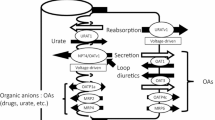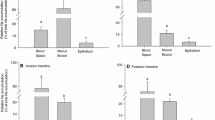Abstract
Olsalazine (OLZ), a relatively new form of 5-aminosalicylic acid (5-ASA), is being used for the treatment of colitis. A major side effect of olsalazine is diarrhea, reported in 12–25% of patients. One suggested mechanism for this side effect is enhanced ileal water and electolyte secretion. We propose that OLZ may also inhibit ileal bile acid (BA) transport, resulting in choleretic diarrhea. This would result in excess BAs reaching the colon, with consequent BA-induced secretory diarrhea. Therefore, we studied the effect of OLZ on rat ileal absorption of taurocholate. BA uptake was determined in rat ileal segments, everted sacs, brush border membrane vesicles (BBMV), andXenopus laevis oocytes. Segments and everted sacs were treated with 5 mM OLZ for 30 min prior to and throughout 10-min taurocholate (Tc) uptake. Terminal ileal BBMV were used to study the effect of OLZ on sodium-dependent bile acid uptake independent of cellular metabolism. Direct effects on the bile acid carrier were examined usingXenopus laevis oocytes expressing the cloned apical rat ileal BA transporter. In ileal segments 5 mM OLZ inhibited 10-min Tc uptake by 69.4±8.8% (P<0.01) (N=10 animals). Increasing concentrations of OLZ resulted in a dose-dependent inhibition of Tc uptake. Ten-minute Tc uptake with 0.5, 1.0, 2.0, 2.5, and 5 mM OLZ was inhibited by 13.5, 39.6, 49.7, and 70.5%, respectively. In BBMV, OLZ inhibited 45-sec Tc uptake in a dose-dependent manner but did not effect Na-dependentl-alanine uptake. Kinetic analysis revealed a noncompetitive inhibition by 2 mM olsalazine. Olsalazine, 5 mM, also inhibited Na-dependent uptake of Tc into oocytes, which expressed the rat ileal sodium-dependent bile acid transporter (8.0±3.7 vs 2.6±2.0 pmol/oocyte/hr,P<0.001). OLZ inhibits sodium-dependent Tc uptake and transmucosal transport in the rat ileum in a dose-dependent manner. This inhibition is relatively specific, noncompetitive, and does not require intact cellular mechanisms. This effect of OLZ on ileal function may contribute to the diarrhea frequently observed with this drug.
Similar content being viewed by others
References
Campbell DES, Berglindh T: Pharmacology of olsalazine. Scand J Gastroenterol 23(suppl 148):7–12, 1988
Sandberg-Gertzen H, Jarnerot G, Bukhave K, Lauritsen K, Rask-Madsen J: Effect of azodisal sodium and sulphasalazine on ileostomy output of fluid and PGE2 and PGF2 in subjects with a permanent ileostomy. Gut 27:1306–1311, 1986
Pamukcu R, Hanauer S, Chang E: Effect of disodium azodisalicylate on electrolyte transport in rabbit ileum and colonin vitro. Gastroenterology 95:975–981, 1988
Mohsen A, Mulvey D, Priddle J, Parson DS, Jewell DP: Effects of olsalazine in the jejunum of the rat. Gut 28:346–352, 1987
Sellin JH: Intestinal electrolyte absorption and secretion. Gastrointestinal Disease. Philadelphia, WB Saunders, 1993
Bjarnason I, Zanelli G, Smith T, Prouse P, Williams P, Smethhurst P, Delacey G, Gumpel MJ, Levi AJ: Nonsteroidal anti-inflammatory drug-induced Intestinal Inflammation in humans. Gastroenterology 93:480–489, 1987
TakiKawa H, Sugiyama Y, Ookhtens M, Fernandez-Checa J, Kaplowitz N: Inhibition of intracellular bile acid transport by indomethacin delays biliary excretion. AASLD 12:895, 1990 (abstract)
Chawla A, Schneideman S, Karl PI, Fisher SE: Effect of olsalazine and 5-aminosaslicylic acid on bile salt. Am J Gastroenterol 86(9):1345, 1991 (abstract 219)
Reymann A, Braun W, Drobik C, Woermann C: Stimulation of bile acid active transport related to increased mucosal cyclic AMP content in rat ileumin vitro. Biochim Biophys Acta 1011:158–164, 1989
Matthews DM, Laster L: Kinetics of intestinal active transport of five neutral amino acids. Am J Physiol 208(4):593–600, 1965
Moyer MS, Heubi JE, Goodrich AL, Balistreri WF, Suchy FJ: Ontogeny of bile acid transport in brush border membrane vesicles from rat ileum. Gastroenterology 90:1188–1196, 1986
Shneider BL, Moyer MS: Characterization of endogenous carrier-mediated taurocholate efflux fromXenopus laevis oocytes. J Biol Chem 68:6985–6988, 1993
Shneider B, Dawson P, Christie D, Wong M, Suchy F: Cloning and molecular characterization of the ontogeny of the rat ileal sodium-dependent bile acid transporter. Gastroenterology 106:A633, 1994
Hagenbuch B, Stieger B, Foguet M, Lubbert H, Meier PJ: Functional expression cloning and characterization of the hepatocyte Na+/bile cotransport system. Proc Natl Acad Sci USA 88:10629–10633, 1991
Sandberg-Gertzen H, Ryde M, Jarnerot G: Absorption and excretion of a single 1-g dose of azodisal sodium in subjects with ileostomy. Scand J Gastroenterol 18:107–111, 1983
Lauritsen K, Laursen Staerk L, Bukhave K, Madsen J: Long-term olsalazine treatment. Gut 29:974–982, 1988
Lauritsen K, Laursen LS, Bukhave K, Rask-Madsen J: Colonic prostagladin E2 levels and olsalazine metabolism in relapsing ulcerative colitis; implications for controlled trials in the long term. Scand J Gastroenterol 23(suppl 148):76–80, 1988
Mekhjian H, Phillips S, Hofmann A: Colonic secretion of water and electrolytes induced by bile acids: Perfusion studies in man. J Clin Invest 50:1569–1577, 1971
Jarnerot G, Sandberg-Gertzen H, Tobiasson P, Vikterlof KJ: Olsalazine does not increase the bile acid losses in subjects with a permanent ileostomy. Scan J Gastroenterol 23(4):489–492, 1988
Buchwald H, Varco R, Matts J, Long JM, Titch LL, Campbell GS, Pearch MB, Edmiston A, Smink RD, Sawin HS, et al: Effect of Partial Ileal Bypass Surgery on mortality and morbidity from coronary heart disease in patients with hypercholesterolemia. N Engl J Med 323(14):946–955, 1990
Author information
Authors and Affiliations
Additional information
Supported in part by a grant from Reach Out For Youth with IBD and a gift from Ruth & Leonard Litwin and by grants from the National Institute of Health (DK02076,34989,43509, HD07388, HD20632 and HD27757).
This work was presented in part at the American Gastroenterological Association meeting, Boston, Massachusetts, May 19, 1993.
Address for reprint requests: Dr. Anupama Chawla, Pediatric Gastroenterology, North Shore University Hospital-Cornell University Medical College, 300 Community Drive, Manhasset, New York 11030.
Rights and permissions
About this article
Cite this article
Chawla, A., Karl, P.I., Reich, R.N. et al. Effect of olsalazine on sodium-dependent bile acid transport in rat ileum. Digest Dis Sci 40, 943–948 (1995). https://doi.org/10.1007/BF02064181
Received:
Accepted:
Issue Date:
DOI: https://doi.org/10.1007/BF02064181




